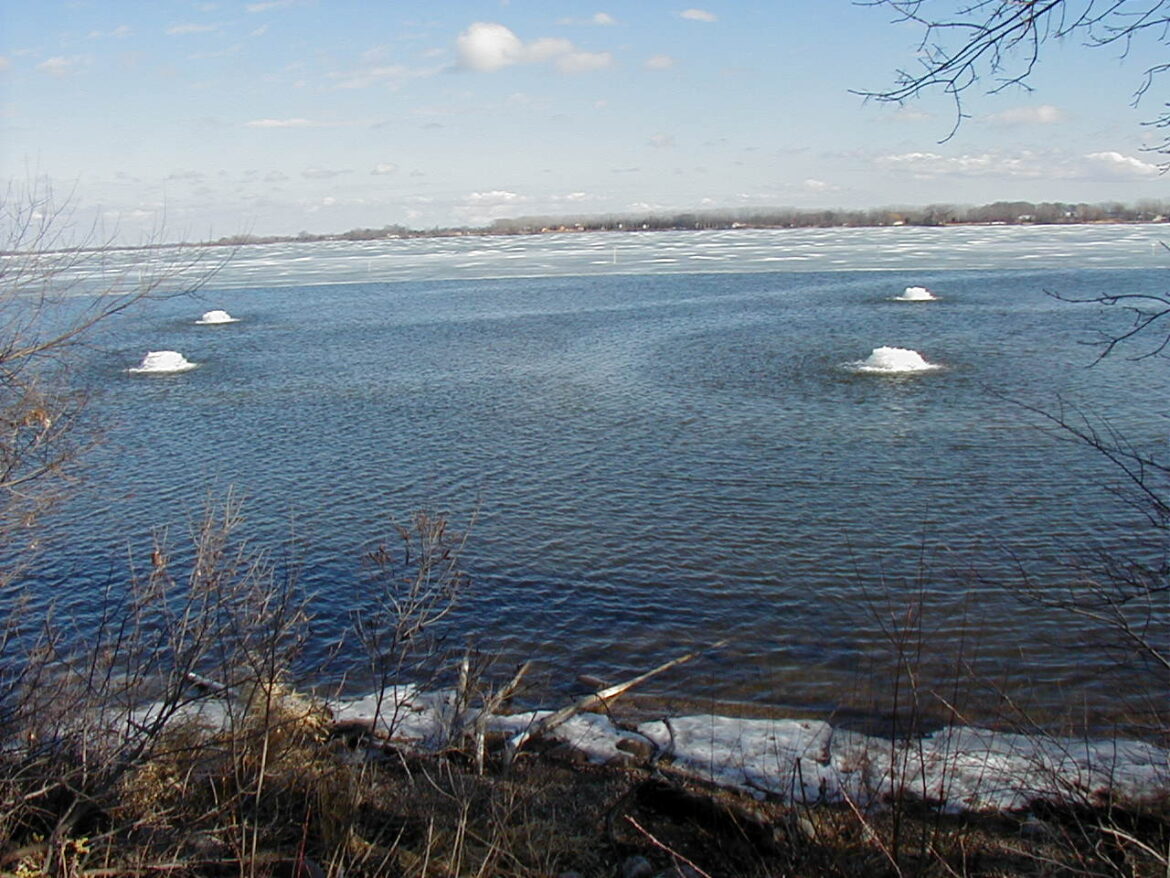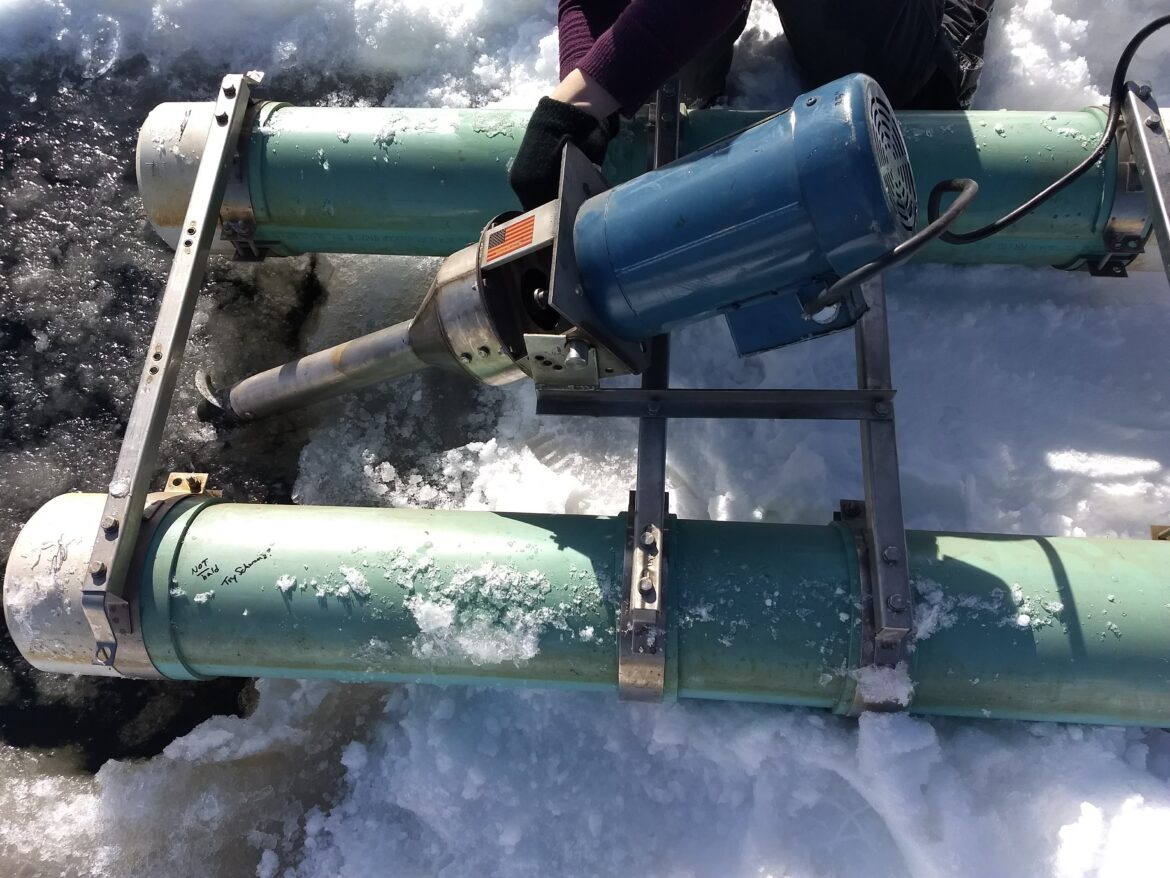
Aire-O2 systems float on the surface of lakes pushing air down into the water to aerate it. Image: Minnesota Department of Natural Resources
By Taylor Haelterman
As lakes thaw this spring, you might spot dead fish, experts warn.
That’s startling, but winterkill this time of year is normal, said Gary Whelan, the fisheries research manager for the Michigan Department of Natural Resources.
It occurs when ice and snow cover a body of water and the fish run out of oxygen, Whelan said.
It happens most often in shallow lakes with a lot of plant growth. Snow piles up on the ice and stops sunlight from reaching the underwater plants. Without that light, the plants go from producing oxygen through photosynthesis to dying, decaying and using up oxygen, Whelan said.

Dead fish from a winterkill preserved by cold water may not be noticed until long after the ice thaws. Image: Michigan Department of Natural Resources
If enough plants die under the ice, they use up all the oxygen in the water. Fish and other aquatic animals that need oxygen won’t survive, he said.
How many fish might die is hard to predict. It could be trending to less often. As the climate warms, lake ice decreases. That means winterkill conditions may occur less.
“We had kind of an odd winter,” Whelan said. “Usually, they’re worse if you get early ice cover and snow cover for long periods of time. But this year we didn’t really get ice cover in much of our state until mid-January, or later. Then we got really heavy ice cover and a lot of snow.”
The impacts of fish kills vary. Overcrowded lakes can benefit, but killing off a lake’s entire population is never a good thing, Whelan said.
Some Minnesota residents try to prevent winterkill by aerating lakes as if they were big aquariums.
Aeration increases oxygen in the water by opening up the ice and causing the water surface to interact with air.
The most common systems are bubblers under the water or pontoons that blow air into the water, said Brian Schultz, the assistant regional fisheries manager for the Minnesota Department of Natural Resources.
Minnesota has a statewide aeration permit program. Counties or groups like sportsmen’s clubs purchase the aeration systems, pay for upkeep and pay a fee to the Department of Natural Resources.

Helixor systems aerate the lake from under the water by pushing bubbles upwards to disturb the surface. Image: Minnesota Department of Natural Resources
The state has issued nearly 290 aeration permits for winterkill. Southern lakes, which tend to be shallower and more heavily vegetated, account for 255 of the permits, Schultz said. Fifty-five are in operation, about what is expected for this time of year.
Schultz noticed a decrease in aeration in recent years.
This could be because people worry about the potential dangers of open water on the lakes and the high cost of running aerators.
Or it could be because of the turn towards boom-and-bust fishery. That’s when a lake that dies off has good fishing the following year because there are fewer predatory fish in the water, Schultz said.
Another reason aeration systems are used less might be the decreasing number of winterkills over the past few years, which could be due to climate change, he said.
Of the 6,100 lakes in Minnesota that provide fishing opportunities, 2,600 have potential for winterkill, Schultz said.
“But you don’t see that much winterkill anymore, and I’m thinking it has to do with climate change,” he said.
Ice has covered Minnesota’s lakes for shorter periods recently, preventing winterkill conditions, Schultz said.
It’s harder to tell how winterkill in Michigan is impacted by climate change because its weather is moderated by the surrounding Great Lakes, but Whelan also expects to see a reduction in kills as climate change goes on and lakes get less ice.
Unlike Minnesota, Michigan does not have an aeration program. The state prefers to deal with winterkill by managing bodies of water better and reducing nutrient loads, fertilizers and vegetation, Whelan said.
“[Aeration] is expensive and it doesn’t always work,” he said. “If you’re willing to put the investment in you can get some to work, but a lot of them will not work even with that aeration. It’s a double-edged sword.”
The Michigan Department of Natural Resources asks the public to report fish kills to their Eyes in the Field website to help it better manage the state’s bodies of water.